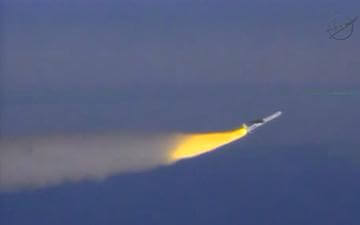The spacecraft was launched from a plane that took off from Vandenberg Air Force Base in California over the deserts of the western United States, and was carried into space on a Pegasus XL rocket manufactured by Orbital Sciences.

The IRIS spacecraft (IRIS) stands for Interface Region Imaging Spectrograph that will study the sun was launched yesterday (Friday) and reached its orbit. This is confirmed by the American space agency NASA.
The spacecraft was launched from a plane that took off from Vandenberg Air Force Base in California over the deserts of the western United States, and was carried into space on a Pegasus XL rocket manufactured by Orbital Sciences. Currently, this is the last Pegasus launch commissioned by NASA from the commercial company. NASA's Launch Services Program at the Kennedy Space Center in Florida managed the countdown and the launch.
Iris is a small spacecraft whose mission is to observe the movement of matter moving around the Sun, gathering energy and heating up as it moves through the region of the Sun's lower atmosphere that little is known about. This interface zone between the photosphere and the corona where the heat reaches millions of degrees. This interface region is also responsible for the solar wind.
The researchers who will help Iris will try to answer basic questions and understand how the strong energy emitted from the sun is created. The data you transmit will help us understand how the energy moves from the surface of the sun to the hot corona and its particles are heated on the way from about 6,000 degrees to a million degrees.
The Iris mission, will use a telescope in the ultraviolet range and will be able to observe contours with a diameter of 200 kilometers or more. It will measure about one percent of the surface of the sun.
"Iris will show the Sun's chromosphere in greater detail than ever before," says Adrian Dow, project scientist. "I think we are about to see something we did not expect."
Iris is a small NASA spacecraft that will complete the SDO and Hindoo missions that study the activity of the Sun's atmosphere and its effect on Earth. SDO and Hinode study the Sun's surface and outer atmosphere respectively, while Iris will observe the area in between.
"Iris will act almost like a microscope for the SDO telescope," says Jim Hull, Iris mission manager. "She will look closely at a specific area to see how the changes in matter and energy take place there."
According to him, the combination of the three spacecraft will give us a more complete view of the sun. "Iris will improve our understanding of the interface region where most of the sun's ultraviolet emission is generated. This emission affects the space environment near the Earth and the Earth's climate. Solar activity such as coronal mass ejections and solar flares are of interest to spacecraft and satellite designers who seek to find ways to protect devices and electronics from these radiations.
"We are looking for answers to the question why everything starts with the sun". says the Lord.
Orbital Sciences' Pegasus satellite is the only winged launcher used by NASA. Although it is small compared to the huge launchers that lift heavy satellites into orbit and spacecraft to other worlds, Pegasus' size and flexibility made it possible to perform many tasks that were too small for a larger launcher.
"Pegasus has been a successful launcher for NASA," says Tim Dunn, Iris' launch manager. "We have so far had 18 successful launches with Pegasus. The team is dynamic and flexible. They managed to complete a lot of work in a very short time." said.
The carrier plane, model L-1011 climbed to a height of 39 thousand feet and then it ejected the Pegasus launcher which continued into space on its own. The solid-fueled first stage of Pegasus began burning about five seconds after falling from the plane, then arced and stabilized in an upward direction as its main wings gave it lift and the three fins on its back helped it navigate through the thick layer of Earth's lower atmosphere.
The rocket fired the first stage for 73 seconds and then disengaged. The wingless second stage ignited 94 seconds after launch and quickly propelled Iris into space. The third stage then took command and moved Iris to its intended orbit about 13 minutes after launch.
As mentioned, this is the last mission of Pegasus because there are no more small spaceships left suitable for Pegasus' capabilities. The launch was carried out from the west coast because the spacecraft is designed to circle the Earth in a polar orbit, meaning it will pass over the North Pole and the South Pole the entire time. In this orbit, she will be able to observe the sun freely for eight months of the year," Hal said.
Once Iris opens up its solar collectors and supplies power to the systems, as well as opens up the telescope, scientists hope to see a flow of data fairly quickly.
According to Dao, the scientists know what questions they want to get answers to but in such missions, there are always surprises.
